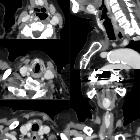Ductus thyreoglossus


The thyroglossal duct is an epithelium-lined connection between the foramen cecum and the thyroid that forms during the descent of the thyroid during embryological development. It usually involutes in the 8th-10th week of gestation.
Gross anatomy
The thyroglossal duct arises from proximal primitive foregut between the first and second pharyngeal pouches at the foramen cecum, located at the junction of the anterior two thirds and posterior third of the tongue . From there it passes anterior to the body of the hyoid bone, curving backwards and superiorly to reach behind the bone before once more turning inferiorly and continuing to the isthmus of the thyroid. The pyramidal lobe, if present, marks this point. The tip of the duct bifurcates, forming the two lobes of the gland. The parafollicular cells (C cells) responsible for calcitonin production are derived from separate tissue, the ultimobranchial body, a small diverticulum of the fourth pharyngeal pouch.
Variant anatomy
The thyroid may halt at any stage during its descent or leave rests of thyroid tissue along the course of the thyroglossal duct :
Related pathology
Failure of obliteration of the duct may lead to the formation of a thyroglossal duct cyst.
Siehe auch:
- Schilddrüse
- Ductus thyreoglossus Zyste
- Lobus pyramidalis
- ektopes Schilddrüsengewebe
- Zungengrundstruma
- persistent thyroglossal duct
und weiter:

 Assoziationen und Differentialdiagnosen zu Ductus thyreoglossus:
Assoziationen und Differentialdiagnosen zu Ductus thyreoglossus:





